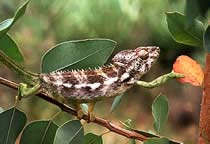Chameleons walk on water

True colours: chameleons probably originated in Madagascar <br>© SPL <br>
Reptile history reveals daring escape from Madagascar
Land-lubber chameleons navigated the oceans to spread around the world. Stowed away on tree rafts, the animals were ferried to distant shores, new research suggests1.
Chameleons aren’t good swimmers: their mitten-like feet are made to grasp twigs and trees. Yet the intrepid animals charted the seas several times in the past 26 million years, say Chris Raxworthy of the American Museum of Natural History in New York, and his colleagues.
The team built up a chameleon chronicle by comparing the anatomy and genetics of 52 species worldwide. The creatures originated on the island of Madagascar off southern Africa, they found, and probably spread out of Madagascar in several waves.
“It’s pretty bold,” says Olivier Rieppel, who studies reptile evolution at the Field Museum in Chicago, Illinois, because it seems counter-intuitive. “It’s hard to imagine an animal swimming more awkwardly,” he says.
The lizards’ most likely escape route was an upturned tree, says Rieppel, or chunks of land chewed off by waves. There are also suggestions that a land bridge once linked Madagascar and mainland Africa – in which case the reptiles might have strolled across.
Land or sea
Raxworthy’s idea counters previous accounts of chameleon history: that they originated on the ancient supercontinent Gondwana and were divided when the land mass split.
India and Madagascar together broke away from Africa 165 million years ago; Madagascar and the Seychelles subsequently separated from India. These events occurred long before chameleons first appeared on the planet – 26 million years ago, according to fossil records.
Many other animal and plant species are thought to have evolved when the movement of continental plates created barriers such as seas and mountains. Divided by water or crag, populations are thought to have evolved into new, related species.
This type of hypothesis can be tested by marrying evolutionary trees with geological records
Dispersal hypotheses such as Raxworthy’s are more difficult to check: “There’s a lot more speculation,” says Mark Springer at the University of California in Riverside.
Springer recently showed that the earliest split of the placental mammals into two basic groups coincides with the separation of South America and Africa around 100 million years ago2. Researchers accept that continental movements and ocean navigation play a role in species dispersal. “They’re both very important,” says Springer.
References
- Raxworthy, C. J., Forstner, M. R. J. & Nussbaum, R. A. Chameleon radiation by oceanic dispersal. Nature, 415, 784 – 787, (2002).
- Murphy, W. J., et al. Resolution of the early placental mammal radiation using Bayesian phylogenetics. Science, 294, 2348 – 2351, (2001).
Media Contact
All latest news from the category: Life Sciences and Chemistry
Articles and reports from the Life Sciences and chemistry area deal with applied and basic research into modern biology, chemistry and human medicine.
Valuable information can be found on a range of life sciences fields including bacteriology, biochemistry, bionics, bioinformatics, biophysics, biotechnology, genetics, geobotany, human biology, marine biology, microbiology, molecular biology, cellular biology, zoology, bioinorganic chemistry, microchemistry and environmental chemistry.
Newest articles

First-of-its-kind study uses remote sensing to monitor plastic debris in rivers and lakes
Remote sensing creates a cost-effective solution to monitoring plastic pollution. A first-of-its-kind study from researchers at the University of Minnesota Twin Cities shows how remote sensing can help monitor and…

Laser-based artificial neuron mimics nerve cell functions at lightning speed
With a processing speed a billion times faster than nature, chip-based laser neuron could help advance AI tasks such as pattern recognition and sequence prediction. Researchers have developed a laser-based…

Optimising the processing of plastic waste
Just one look in the yellow bin reveals a colourful jumble of different types of plastic. However, the purer and more uniform plastic waste is, the easier it is to…



